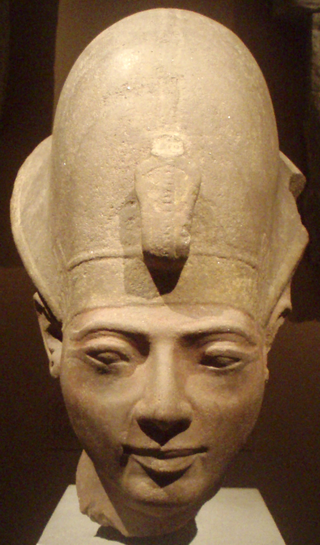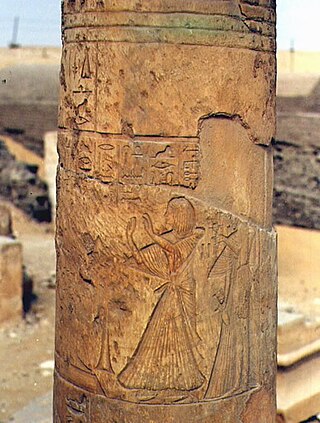Merenptah was an ancient Egyptian prince during the 19th Dynasty, likely to have been a son of Pharaoh Merenptah. [1]
He is known from two statues of Senusret I usurped by Pharaoh Merenptah − found in Tanis and Alexandria, respectively − and from three statue fragments from Bubastis. Since he shares a name with Pharaoh Merenptah, also, his name is similar to that of the crown prince and eventual successor, Seti Merenptah, and he wears an uraeus usually worn by pharaohs only, it is a possibility that he is in fact the same as either of these two, [2] but Prince Merenptah's titles slightly differ from those of the pharaoh and the crown prince, also, the Senusret statues were usurped by Merenptah when he was already a pharaoh. Also, Seti Merenptah used both his names as a prince and as a pharaoh. It is possible that Merenptah's use of a uraeus stems from the power struggle between Pharaoh Merenptah's heirs following his death. [3]

Sobekneferu or Neferusobek was a pharaoh of ancient Egypt and the last ruler of the Twelfth Dynasty of the Middle Kingdom. She ascended to the throne following the death of Amenemhat IV, possibly her brother or husband, though their relationship is unproven. Instead, she asserted legitimacy through her father Amenemhat III. Her reign lasted 3 years, 10 months, and 24 days, according to the Turin King List.

Seti II was the fifth pharaoh of the Nineteenth Dynasty of Egypt and reigned from c. 1203 BC to 1197 BC. His throne name, Userkheperure Setepenre, means "Powerful are the manifestations of Re, the chosen one of Re." He was the son of Merneptah and Isetnofret II and occupied the throne during a period known for dynastic intrigue and short reigns, and his rule was no different. Seti II had to deal with many serious plots, most significantly the accession of a rival king named Amenmesse, possibly a half brother, who seized control over Thebes and Nubia in Upper Egypt during his second to fourth regnal years.

The Uraeus or Ouraeus is the stylized, upright form of an Egyptian cobra, used as a symbol of sovereignty, royalty, deity and divine authority in ancient Egypt.

Merneptah or Merenptah was the fourth pharaoh of the Nineteenth Dynasty of Ancient Egypt. He ruled Egypt for almost ten years, from late July or early August 1213 BC until his death on 2 May 1203 BC, according to contemporary historical records. He was the first royal-born pharaoh since Tutankhamun of the Eighteenth Dynasty.

Amenmesse was the fifth pharaoh of the Nineteenth Dynasty in Ancient Egypt, possibly the son of Merneptah and Queen Takhat. Others consider him to be one of the innumerable sons of Ramesses II. Very little is known about this pharaoh, who ruled Egypt for only three to four years. Various Egyptologists date his reign between 1202 BC–1199 BC or 1203 BC–1200 BC with others giving an accession date of 1200 BC. Amenmesse means "born of or fashioned by Amun" in Egyptian. Additionally, his nomen can be found with the epithet Heqa-waset, which means "Ruler of Thebes". His royal name was Menmire Setepenre.

Bintanath was the firstborn daughter and later Great Royal Wife of the Egyptian Pharaoh Ramesses II.

Amenemhat I, also known as Amenemhet I, was a pharaoh of ancient Egypt and the first king of the Twelfth Dynasty of the Middle Kingdom.

Nubkaure Amenemhat II, also known as Amenemhet II, was the third pharaoh of the 12th Dynasty of ancient Egypt. Although he ruled for at least 35 years, his reign is rather obscure, as well as his family relationships.

The pschent was the double crown worn by rulers in ancient Egypt. The ancient Egyptians generally referred to it as sekhemty (sḫm.ty), the Two Powerful Ones. It combined the White Hedjet Crown of Upper Egypt and the Red Deshret Crown of Lower Egypt.

Isetnofret was one of the Great Royal Wives of Pharaoh Ramesses II and was the mother of his successor, Merneptah. She was one of the most prominent of the royal wives, along with Nefertari, and was the chief queen after Nefertari's death.

Amun-her-khepeshef was the firstborn son of Pharaoh Ramesses II and Queen Nefertari.

Takhat was an ancient Egyptian princess and queen of the 19th Dynasty, the mother of the usurper pharaoh Amenmesse.

Tia or Tiya was an ancient Egyptian princess during the 19th Dynasty.

Sithathoriunet was an Ancient Egyptian king's daughter of the 12th Dynasty, mainly known from her burial at El-Lahun in which a treasure trove of jewellery was found. She was possibly a daughter of Senusret II since her burial site was found next to the pyramid of this king. If so, this would make her one of five known children and one of three daughters of Senusret II—the other children were Senusret III, Senusretseneb, Itakayt and Nofret.
Seti-Merenptah was an ancient Egyptian prince of the late 19th Dynasty, a son of Pharaoh Seti II.
Khenemetneferhedjet(ẖnm.t nfr-ḥḏ.t) was an ancient Egyptian queenly title during the Middle Kingdom. It was in use from the 12th to the early 18th Dynasty. During the 12th Dynasty it also occurred as a personal name. Its meaning is "united with the white crown". The White Crown was one part of the Double Crown of Egypt and is usually interpreted to have represented Upper Egypt, but it is also possible that while the Red Crown represented the king's earthly incarnation, the White Crown represented the eternal, godlike aspect of kingship.
Isetnofret(3s.t-nfr.t; also spelled as Isetneferet, Isisnofret etc.) was an ancient Egyptian female name, meaning “Isis is beautiful”.

The High Priest of Ptah was sometimes referred to as "the Greatest of the Directors of Craftsmanship". This title refers to Ptah as the patron god of the craftsmen.

Isetnofret was a royal woman of Ancient Egypt and, as the Great Royal Wife of Pharaoh Merenptah, she became Isetnofret II.
This page is based on this
Wikipedia article Text is available under the
CC BY-SA 4.0 license; additional terms may apply.
Images, videos and audio are available under their respective licenses.















